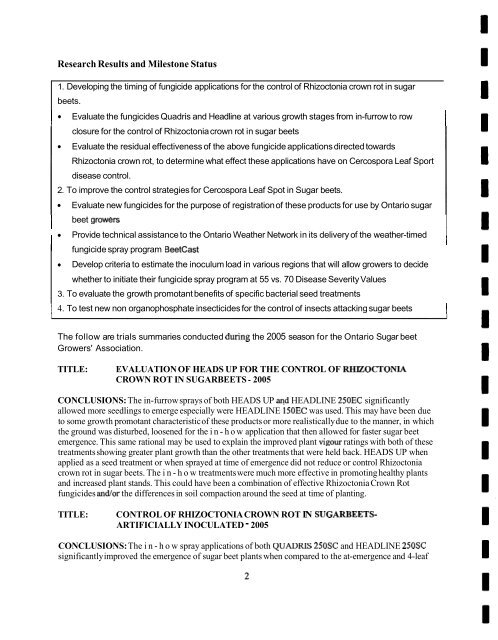ontario sugar beet growers - Atrium - University of Guelph
ontario sugar beet growers - Atrium - University of Guelph
ontario sugar beet growers - Atrium - University of Guelph
You also want an ePaper? Increase the reach of your titles
YUMPU automatically turns print PDFs into web optimized ePapers that Google loves.
Research Results and Milestone Status<br />
1. Developing the timing <strong>of</strong> fungicide applications for the control <strong>of</strong> Rhizoctonia crown rot in <strong>sugar</strong><br />
<strong>beet</strong>s.<br />
1 Evaluate the fungicides Quadris and Headline at various growth stages from in-furrow to row<br />
I<br />
closure for the control <strong>of</strong> Rhizoctonia crown rot in <strong>sugar</strong> <strong>beet</strong>s<br />
Evaluate the residual effectiveness <strong>of</strong> the above fungicide applications directed towards<br />
Rhizoctonia crown rot, to determine what effect these applications have on Cercospora Leaf Sport<br />
disease control.<br />
2. To improve the control strategies for Cercospora Leaf Spot in Sugar <strong>beet</strong>s.<br />
Evaluate new fungicides for the purpose <strong>of</strong> registration <strong>of</strong> these products for use by Ontario <strong>sugar</strong><br />
I <strong>beet</strong> <strong>growers</strong><br />
I<br />
I<br />
Provide technical assistance to the Ontario Weather Network in its delivery <strong>of</strong> the weather-timed<br />
I<br />
fungicide spray program BeetCast<br />
Develop criteria to estimate the inoculum load in various regions that will allow <strong>growers</strong> to decide<br />
whether to initiate their fungicide spray program at 55 vs. 70 Disease Severity Values<br />
3. To evaluate the growth promotant benefits <strong>of</strong> specific bacterial seed treatments<br />
1 4. To test new non organophosphate insecticides for the control <strong>of</strong> insects attacking <strong>sugar</strong> <strong>beet</strong>s I<br />
The follow are trials summaries conducted during the 2005 season for the Ontario Sugar <strong>beet</strong><br />
Growers' Association.<br />
TITLE:<br />
EVALUATION OF HEADS UP FOR THE CONTROL OF RHIZOCTONIA<br />
CROWN ROT IN SUGARBEETS - 2005<br />
CONCLUSIONS: The in-furrow sprays <strong>of</strong> both HEADS UP q d HEADLINE 250EC significantly<br />
allowed more seedlings to emerge especially were HEADLINE 150EC was used. This may have been due<br />
to some growth promotant characteristic <strong>of</strong> these products or more realistically due to the manner, in which<br />
the ground was disturbed, loosened for the in-how application that then allowed for faster <strong>sugar</strong> <strong>beet</strong><br />
emergence. This same rational may be used to explain the improved plant vigour ratings with both <strong>of</strong> these<br />
treatments showing greater plant growth than the other treatments that were held back. HEADS UP when<br />
applied as a seed treatment or when sprayed at time <strong>of</strong> emergence did not reduce or control Rhizoctonia<br />
crown rot in <strong>sugar</strong> <strong>beet</strong>s. The in-how treatments were much more effective in promoting healthy plants<br />
and increased plant stands. This could have been a combination <strong>of</strong> effective Rhizoctonia Crown Rot<br />
fungicides andlor the differences in soil compaction around the seed at time <strong>of</strong> planting.<br />
TITLE:<br />
CONTROL OF RHIZOCTONIA CROWN ROT IN SUGARBEETS-<br />
ARTIFICIALLY INOCULATED - 2005<br />
CONCLUSIONS: The in-how spray applications <strong>of</strong> both QUADRIS 250SC and HEADLINE 250SC<br />
significantly improved the emergence <strong>of</strong> <strong>sugar</strong> <strong>beet</strong> plants when compared to the at-emergence and 4-leaf

















